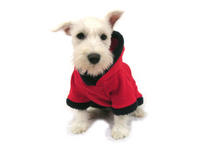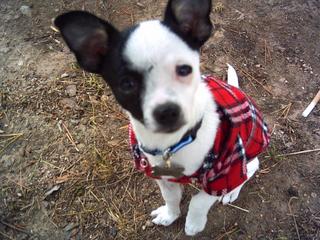Between 15% to 20% of all dogs in the United States suffer from allergies. As in humans, allergies may manifest in different ways producing varied symptoms in your pet. Knowing the signs of allergy suffering will bring your dog faster relief and happier days. As with any pet related medical issue, always consult your veterinarian if you suspect a problem.
Food AllergiesDogs can develop allergies or food sensitivities at any point during their lives. Often, dogs eat the same type of food for years, so their diet may be overlooked. The most common problem causing foods include:
Soy products
Beef
Chicken
Corn
Wheat
Pork
Milk
Whey
Eggs
Fish
Lamb
Chemical Preservatives
Artificial Sugars
Symptoms of Food Allergies often include:
Itchy Skin
Ear Inflammations
Ear Scratching
Frequent Licking or Biting of Paws
Anal Itching
Face Rubbing
Head Shaking
Loss of Appetite
Coughing
Remedy:
Once food allergies have been determined to be the cause of your dog’s symptoms, eliminating the potential allergens from your pet’s diet is the first course of action. Begin by excluding foods which are known instigators (see list above). Look for either a commercial product which contains ingredients your dog has not eaten before or prepare home-made food for your dog consisting of two parts starch to one part protein. Suggested protein alternatives include duck, salmon, venison, or rabbit. Potatoes are suggested as an alternative starch. All ingredients should be served boiled and fed in normal proportions to your dog’s regular diet. Once prepared, the food can be individually packaged, frozen, and then used as needed. Home cooked diets are generally nutritionally incomplete and should only be used temporarily during the test period.
One item at a time, begin adding ingredients present in your dog’s former food to his new food. If symptoms reappear, the food allergen should be easily identified. During the test period, make certain your dog eats only the new food. Eliminate treats, dog bones, table scraps, rawhide, chews, vitamins, etc. Once the offending food has been identified, look for a commercial food which does not contain that ingredient.
Atopic Dermatitis
Atopic dermatitis, or canine atopic dermatitis, is an allergic skin disease generally caused by an immune hypersensitivity to environmental substances such as mold spores or dust mites. Indications your dog has this sensitivity generally present themselves by the age of two. Food and flea allergies, as well as parasitic infections, should be ruled out first as their symptoms are similar to atopic dermatitis.
Symptoms of Atopic Dermatitis include:
Excessive Grooming
Licking or Chewing of the Paws, Stomach, or between the Toes
Change of Stomach Skin Color to an Irritated Red
Ears which are Red or Hot to the Touch
Remedy:
Skin allergy testing can be conducted by your veterinarian to determine your dog’s specific allergy.
Flea AllergyCaused by the saliva secreted by the flea, a flea allergy is the most common form of dog allergy. Sometimes the bite of a single flea may cause your dog to launch into fits of self-chewing and biting lasting for five to seven days.
Symptoms of Flea Allergy Include Severe Biting & Chewing of:
The Tail and Surrounding Area
Stomach
Inside hind legs
Remedy:
A skin test can be performed to confirm your dog is allergic to flea saliva. Once a flea allergy has been confirmed, a strict control regimen should be initiated. Flea control products are safer now than they once were with options ranging from topical solutions to pills, shampoos and sprays. Garlic and Brewers Yeast have also been touted to keep fleas away as have weekly topical applications of lavender and eucalyptus oils. However these solutions have not been scientifically confirmed.
Whatever remedy you choose, consult your veterinarian first. Overly strong flea killing preparations may cause your dog more harm than good. Additionally, regular dog grooming (through your dog’s coat and down to the skin) will help find and eliminate fleas and flea droppings.
Inhalant Allergy Inhalant allergies are substances in the environment which cause your dog’s immune system to react, releasing antibodies containing histamines, serotonin, and leukotrienes. Pollens from trees, grass, ragweed as well as mold spores, chemicals, dust mites and wood chips in pet bedding may cause your dog substantial discomfort.
One clue to diagnosing this allergy is timing. Is your dog’s allergy seasonal or year round? If you know to what your dog is allergic, avoidance is the best remedy. To help mitigate possible allergens, use dehumidifiers to reduce mold, air conditioners during pollen season, air cleaners with HEPA filters for dust and pollen residue, and vacuum frequently.
Inhalant Allergy Symptoms Include:
Biting and scratching at the body
Red or Irritated ear flaps which are hot to the touch
Head shaking
Rubbing the face
Severe scratching or biting of the flank, groin, paws and armpit regions
Remedy:
Providing your dog relief may come in the form of a cool bath with colloidal oatmeal, aloe vera, eucalyptus, or a medicated shampoo. However these will only provide your dog temporary relief and will need to be repeated frequently.
Omega 3 and Omega 6 fatty acids are natural anti-inflammatory agents which have proven successful in approximately 20% of dogs tested. Omega 3 fatty acids are found in fish oils such as Cod and Omega 6 fatty acids come from plants containing gamma-linolenic acid – such as evening primrose. Antihistamines have also proven effective in dogs with allergies with one short-term effect being lethargy or tiredness.
Corticosteriods (steroids) are substances which interfere with the function of the immune system and reduce itching by reducing the inflammation. They also affect all the organs in your dog’s body and should be used under medical supervision for short periods of time or in small doses.
Blood tests and intradermal skin testing can also be performed to judge specific reactions to allergens.
Contact AllergiesContact allergies are the least common of dog allergies. Items such as flea collars, grass, shampoos, plants, chemicals, and wood chips may cause allergic reactions. By eliminating the irritant, symptoms should disappear.
If you think your dog may suffer from allergies, keep a journal. Make notes as to the symptoms, their severity, and when they occur. This will help your veterinarian pinpoint the problem and help your dog achieve a speedier recovery.
www.dogclothes-apparel.com
 Now that Fall is upon us, visit www.dogclothes-apparel.com for a wide selection of dog coats, sweaters, and dog hoodies to keep our short-coated friends warm. Dog clothes not only make your dog fabulous, they also serve a practical purpose for the health and well being of your pampered pup.
Now that Fall is upon us, visit www.dogclothes-apparel.com for a wide selection of dog coats, sweaters, and dog hoodies to keep our short-coated friends warm. Dog clothes not only make your dog fabulous, they also serve a practical purpose for the health and well being of your pampered pup. October is almost over and we wanted to share another pampered pup from our photo contest.
October is almost over and we wanted to share another pampered pup from our photo contest.

